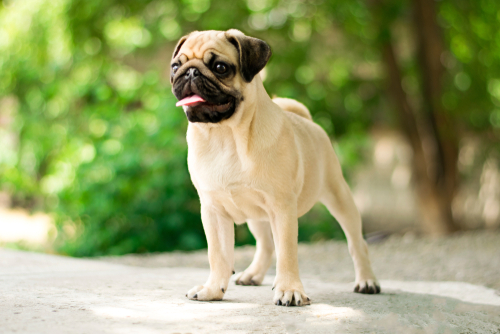5 Dog Breeds That Have Changed Over The Past 100 Years
Posted on Categories Discover Magazine

Tens of thousands of years ago in prehistoric Eurasia, some daredevil made friends with a gray wolf. The millions of domesticated dogs we see today are all likely its descendants, and their enormous diversity masks a remarkable fact: Even after millennia of selective breeding, all of them, from the Chihuahua to the St. Bernard, remain members of the same species.
Canis familiaris displays by far the most variation of any mammal, and it’s still evolving at a steady clip. The mutation rate is so fast because breeders deliberately pair dogs with desirable traits or cross-breed distinct lineages to create novel “designer dogs.” In so doing, they speed up the leisurely process of natural selection, which is indifferent to human notions of canine perfection.
Today, our beloved pets come in 200 breeds (according to the American Kennel Club; the Fédération Cynologique Internationale, or World Canine Organization, uses vastly different standards and recognizes more than twice that number). In just the past century, many of them have undergone major transformations.
Entertaining as it is to compare our favorite dogs to their ancestors, their pedigrees often come with a cost. Because many breeds descend from just a few individuals, they lack genetic diversity, which predisposes them to a host of diseases that mixed breeds escape. In some cases, those diseases directly result from the anatomy dog fanciers have sculpted in their pursuit of each breed’s ideal (or “standard,” in kennel club lingo).
How Dog Breeds Have Changed Over Time
Here are a few breeds that have changed since the advent of photography and their common health complications.
1. Bull Terrier
(Credit: Public domain, via Wikimedia Commons) Bull Terrier Circa 1915
As its name suggests, this breed was originally a mix between bulldogs and terriers. Just like them (and basically all other dogs) the bull terrier once had a clear break between snout and forehead.
Around the turn of the 20th century, however, breeders began to mold its profile into a smooth arc from nose to skull, almost like the slope of a shark’s head. This, its most distinctive feature, is sometimes referred to as an “egg-head,” full and without hollows or indentations. Another key trait is the deep-set, triangular eyes, designed to create what today’s standard calls a “piercing glint.”
Besides their looks, the bull terrier was also bred to mellow out the aggression of its bulldog forebears (themselves bred for bull-baiting until it became illegal in 1835) while still retaining their courage. Common health problems include skin allergies and deafness, which affect nearly 20 percent of white bull terriers.
(Credit:Alexandra Morrison Photo/Shutterstock)
Read More: Our Dogs Do Manipulate Us, According to Science
2. English Bulldog
(Credit:Public domain, via Wikimedia Commons)
Bulldog from 1915
The exact breed that gave the bull terrier half its name no longer exists, its descendants having grown into something new: The dense, heavily jowled watchdogs of the 21st century. Though always a squat creature, today’s English bulldogs are even more thick-set, with more prominent cheek folds that hang well below a massive jaw. They’ve lost much of the agility that earlier bulldogs needed for blood sport.
Australian veterinarian Mark Tenenbaum, founder of The Vet Society, has written that the English bulldog has “almost acquired all possible deleterious breed predispositions over the past century” — everything from difficulty breathing to skin and eye diseases. A 2004 survey by the Kennel Club, the U.K.’s largest dog organization, found that their average lifespan is just over six years, significantly shorter than most breeds.
(Credit:WilleeCole Photography/Shutterstock)
Read More: Dogs and Their Owners Share Similar Personality Traits
3. Pug
Portrait of Pug of the Vom Rath Family, by Conradijn Cunaeus, c. 1850-80, Dutch watercolor painting (Credit:Everett Collection/Shutterstock)
Pugs are among the few breeds with an established claim to antiquity. Historians generally agree they originated in the first millennium B.C. in China, bred as companion animals. These days, they’re known and loved for their adorably smushed faces, but that supposedly desirable trait is actually the main cause of their health issues.
Just a century or two ago, their snouts were considerably longer and healthier. Now pugs, like other “brachycephalic” breeds with ludicrously short noses (including bulldogs), typically struggle with breathing due to their deformed respiratory tracts. The condition is so severe and prevalent that researchers from the Royal Veterinary College argue the pug “can no longer be considered as a typical dog.”
(Credit:Studio number 94/Shutterstock)
Read More: Why Dogs Sometimes Don’t Like Certain People
4. German Shepherds
(Credit:Heinrich Sperling, Public domain, via Wikimedia Commons)
Once a lean dog of merely 50 pounds, the German shepherd is now a lumbering, barrel-chested creature that reaches nearly twice that weight. That shift occurred as breeders adapted them for use in guarding and police work, as well as herding. But in addition to altering their appearance and abilities, the dramatic change in proportions has led to musculoskeletal problems.
Shepherds are prone to hip and elbow dysplasia, painful genetic diseases in which the ball-and-socket joints fit together poorly. That condition, as well as loss of muscle control in the hindlegs that renders them unable to stand, has lowered the breed’s lifespan to an average of 10 years.
(Credit:Rade Kovac/Shutterstock)
Read More: Why Do Dogs Tilt Their Heads to One Side?
5. Neapolitan Mastiff
(Credit:IlSistemone, Public domain, via Wikimedia Commons)
“The essence of the Neapolitan,” the American Kennel Club states, “is his bestial appearance, astounding head and imposing size and attitude.” Surely, “astounding” is the only way to describe the mountain of excess skin that enfolds this breed’s gigantic face.
Weighing in at anywhere from 100-200 pounds, the Neo, like the German Shepherd and many other large dogs, suffers from several size-related problems. Besides hip dysplasia, they’re susceptible to bloat, which happens when the stomach fills with gas and twists, causing abdominal pain.
(Credit:Michael J Magee/Shutterstock)
Read More: Dogs Have Co-Evolved With Humans Like No Other Species